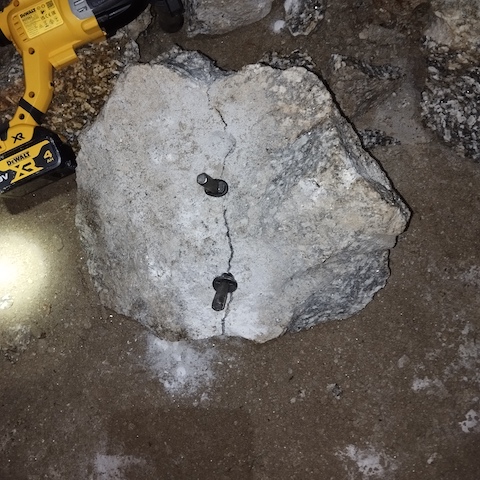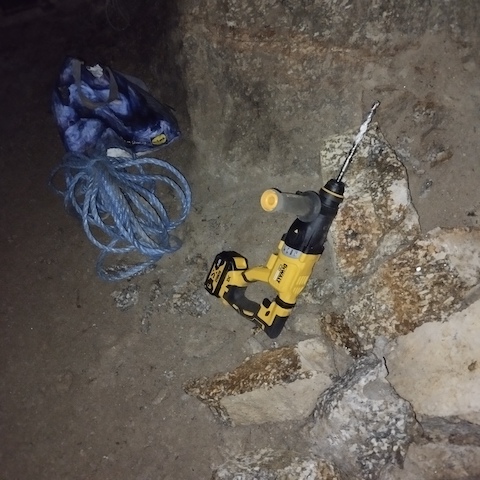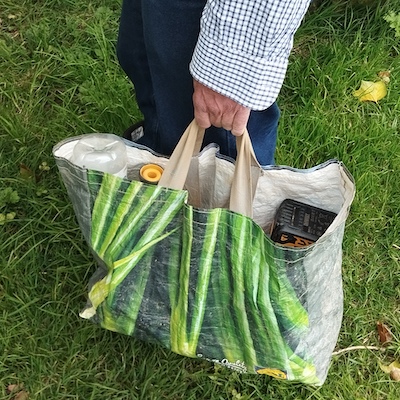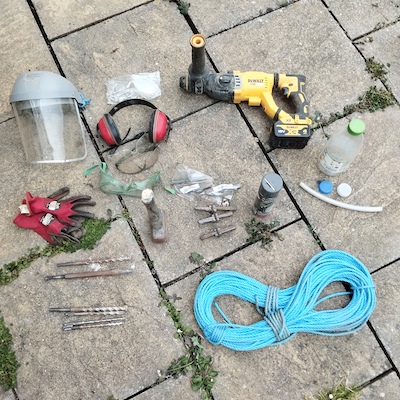
First boulder split
An unexpected success! This is a new method. Though obvious - search of the Web ("YouTube" a good candidate) will surely find plenty of other instances of the same method.
Prior explanation : Condurrow mine is entirely in granite. Hard granite of the Carn Brea slope and plateau.
At Condurrow mine there are sub-levels up stopes where, when used as a training mine, there was blasting where not enough charge was used. So the rock was not shattered, being fractured into large-ish "boulders" part-obstructing those levels.
Which need disposing of.
The rocks are too large to move easily.
Hence must be broken-up.
In a mine this is a "new possibility", because of a mass-produced
"new" tool, the "cordless" battery-powered "SDS" drill
(rotary-plus-impact). The "SDS" drill-bit and chuck system delivers a
useful impact force - and has been available for some time.
The "new" part is batteries - currently Li-ion batteries - now deliver
enough to power a carryable "cordless" SDS-drill which will capably
drill stone.

First boulder split

The drill - "SDS" rotary-plus-impact "cordless" drill

Split stone with the "feathers" used (large middle hole made by
powerful compressed-air-powered mining rock-drill - but rock still
wouldn't then split)
For what it's worth - I needed to drill with a 14mm masonry bit (tungsten-carbide tipped) to use "my" "10mm" "feathers" (the "feathers" are not accurately described (?)).
The "tool-store" drill, seen middle picture, took some careful
choosing at some effort.
It is an unfashionable form but packs a lot more impact power for its
size, weight and cost than the new favoured form.
In explanation - "my" drill is long-ish, which is no problem in the
mine for this task. However in "domestic" building work the drill has
to fit transverse between floor-joists, into tight corners, etc
- so a shorter "block-shaped" form is needed. So "my" drill is
optimum for a niche application.
On a pragmatic basis which really matters "in the real world" : this
drill takes batteries I already have for impact drivers for
wood-screws, pistol-grip drills for wood and metal, etc.
In-effect it's the biggest tool for the job which takes "small tool"
batteries.
So I could buy the "bare" tool; a big cost saving. For the mine
expeditions I can bring several batteries if the task is large - at no
extra cost.
Coming down the mine - a rough environment - this must be an economical-cost piece of kit.
That no setup is involved, and the "kit" is readily carried in case the need to split rocks is encountered, is a "winning" aspect of this method.
There was no satisfactory solution for this task.
That said : here's a round-up of the topic...
Equipment down mines generally uses compressed air power.
This compressed-air-powered rock-drill will drill a 32mm (typically comes out at 34mm) diameter hole 1.5m into hard granite in a few minutes.
It needs a diesel compressor at the surface because its compressed air use is far higher than an electric compressor on the mine's electricity supply would be capable of.
Jumping ahead - the holes this drill makes often do not weaken the stone enough it will split with sledgehammer blows.
Basically it's the size of the task of mobilising the compressed-air supply and getting the rock-drill into place.
What was done was when the air-compressor was running for other reasons and everyone got a chance to try the rock-drill. But viable and an effective solution for this task it was not.
"puny" hardly starts to compare my "cordless" SDS drill to the compressed-air-powered rock-drill.
Stop rotation - impact only - and put in a chisel and it can make no more than a little chip in the granite before it can do no more.
It's the efficiency of what it makes possible - getting the "feathers" into those small (in diameter and depth) sockets in the boulders.
The 14mm hole diameter needed for the "feathers" is probably the upper
limit of this "cordless" SDS-drill into granite.
It may be that "piloting" at about 6mm drill size then drilling to
14mm has advantages. To be measured if a lot of this task is
encountered.
Very pleasing.
I was surprised this worked. Then not only worked but seemingly
exactly meets the need.
I systematically worked at it, maximising the chance of it working.
While mindful of the probability (low-ish?) of "something novel"
working. "If it would work - why hadn't it been done
before?", etc.
However; the logic aligned with realities and the solution did work.
See next mine day where applied as "production" method - it works - well...

What's in the kit:

With more explanation ...
(R. Smith, 15Mar2024, 21Mar2024 (update), 26Apr2024 (pics-portable))